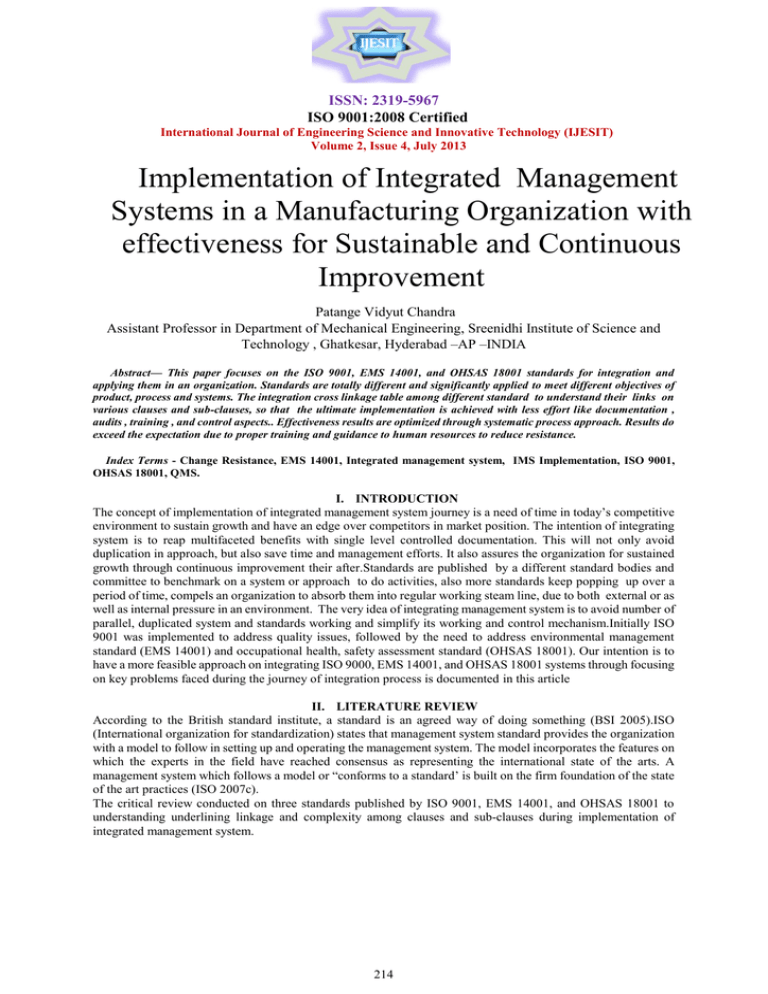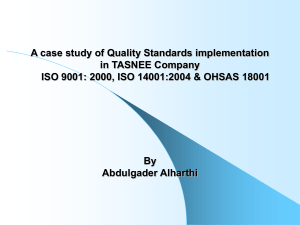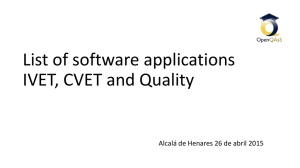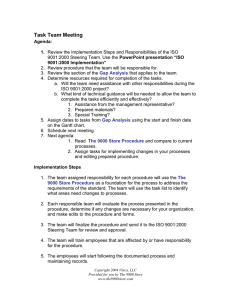Implementation of Integrated Management Systems in a
advertisement

ISSN: 2319-5967 ISO 9001:2008 Certified International Journal of Engineering Science and Innovative Technology (IJESIT) Volume 2, Issue 4, July 2013 Implementation of Integrated Management Systems in a Manufacturing Organization with effectiveness for Sustainable and Continuous Improvement Patange Vidyut Chandra Assistant Professor in Department of Mechanical Engineering, Sreenidhi Institute of Science and Technology , Ghatkesar, Hyderabad –AP –INDIA Abstract— This paper focuses on the ISO 9001, EMS 14001, and OHSAS 18001 standards for integration and applying them in an organization. Standards are totally different and significantly applied to meet different objectives of product, process and systems. The integration cross linkage table among different standard to understand their links on various clauses and sub-clauses, so that the ultimate implementation is achieved with less effort like documentation , audits , training , and control aspects.. Effectiveness results are optimized through systematic process approach. Results do exceed the expectation due to proper training and guidance to human resources to reduce resistance. Index Terms - Change Resistance, EMS 14001, Integrated management system, IMS Implementation, ISO 9001, OHSAS 18001, QMS. I. INTRODUCTION The concept of implementation of integrated management system journey is a need of time in today’s competitive environment to sustain growth and have an edge over competitors in market position. The intention of integrating system is to reap multifaceted benefits with single level controlled documentation. This will not only avoid duplication in approach, but also save time and management efforts. It also assures the organization for sustained growth through continuous improvement their after.Standards are published by a different standard bodies and committee to benchmark on a system or approach to do activities, also more standards keep popping up over a period of time, compels an organization to absorb them into regular working steam line, due to both external or as well as internal pressure in an environment. The very idea of integrating management system is to avoid number of parallel, duplicated system and standards working and simplify its working and control mechanism.Initially ISO 9001 was implemented to address quality issues, followed by the need to address environmental management standard (EMS 14001) and occupational health, safety assessment standard (OHSAS 18001). Our intention is to have a more feasible approach on integrating ISO 9000, EMS 14001, and OHSAS 18001 systems through focusing on key problems faced during the journey of integration process is documented in this article II. LITERATURE REVIEW According to the British standard institute, a standard is an agreed way of doing something (BSI 2005).ISO (International organization for standardization) states that management system standard provides the organization with a model to follow in setting up and operating the management system. The model incorporates the features on which the experts in the field have reached consensus as representing the international state of the arts. A management system which follows a model or “conforms to a standard’ is built on the firm foundation of the state of the art practices (ISO 2007c). The critical review conducted on three standards published by ISO 9001, EMS 14001, and OHSAS 18001 to understanding underlining linkage and complexity among clauses and sub-clauses during implementation of integrated management system. 214 ISSN: 2319-5967 ISO 9001:2008 Certified International Journal of Engineering Science and Innovative Technology (IJESIT) Volume 2, Issue 4, July 2013 III. OBJECTIVE OF INDUSTRY Integrated management is a reliable expression of the company’s sense of responsibility and is also the cornerstone of company policy.This policy is based on Customer orientation Business-process orientation Employee orientation Product responsibility Responsibility for environmental, health and safety Dialog with the public Continuous improvement Large organizations, or ones with complicated processes, could not function well without management systems, So management system standards provide an organization with an international, state-of-the-art model to follow The main reason for having a system of integration standard is to have a single document with no duplication as such during managing of different standard on a parallel platform. As standards have different objective to be fulfilled to meet the accreditation requirement, the very control and continuous efforts on its improvement need to be supported through documentation audits, corrective actions, management review … etc. In order to be really being efficient and effective management of scarce resources, including time, the organization has to handle the complex standard in a smart way of doing things by customizing it. As accreditation agencies conduct 3 RD party audits at regular intervals the very gaps in working need to be filled optimally. The communication systems and integration do simplify the roles and responsibilities for all peoples in the organization. A. Major Gaps in Industrial Systems prior to initiation of IMS implementation Not familiar with the IMS audit requirements; Unclear integration structure; Difficult to update the documents especially if those QMS, EMS, OHSAS procedures were written together; Quality Manager and concerned staff may have to handle more workload with several management systems in place. Some EMS, OHSAS requirements were difficulties to implement, e.g. less using plastic and wooden package of goods deliver protection. Monitoring of their activities would be hard, reducing impact of dust pollution on both internal and external environments in Cement Company IV. PRINCIPLE OBJECTIVES OF ISO 9001, EMS 14001, AND OHSAS 18001 STANDARD The standards under consideration for integration are originated with the intention to benchmark best practices concerned with process, product and system, environment, risk management..etc. . This assures the organization of their coveted benefits, only if they are able to adapt to line of activities specified with controlled approach. BS 575 was first published in 1979 ( BSI 2004 ), presently ISO 9001: 2008 quality management systems standard is in place which states generic requirements to be adhered in real time working systems with full documentation based on which an organization is accredited. A. ISO 9001 Quality Management System Standards. It can help bring out the best in your organization by enabling you to understand your processes for delivering your products/services to your customers. The ISO 9001 series of standards consist of: ISO 9000 – Fundamentals and Vocabulary: this introduces the user to the concepts behind the management systems and specifies the terminology used. ISO 9001 – Requirements: this sets out the criteria you will need to meet if you wish to operate in accordance with the standard and gain certification. The main clauses adopted in ISO 9001, are 1. Management Responsibility , 2 . Resource Management 3. Product realization 4. Measurement and Analysis 5. Continuous Improvement ISO 9004 – Guidelines for performance improvement: based upon the eight quality management principles, these are designed to be used by senior management as a framework to guide their organizations towards improved performance by considering the needs of all interested parties, not just customers. B. Eight principles of Management 1. Customer focusing, 2. Organizations, 3.0 Leadership, 4 Involvement of people, 5. Process Approach, 6.0 Continual improvement, 7.0 Factual Approach 8.0 Supplier Relationship . 215 ISSN: 2319-5967 ISO 9001:2008 Certified International Journal of Engineering Science and Innovative Technology (IJESIT) Volume 2, Issue 4, July 2013 They have to be adopted as part of the real working system along with ISO 9001 Standards systems. C. ISO 14001 Environment Management System BS 7750 was published way back in 1992, presently 14001:2004 environmental management standard exists which states requirement to which organization is accredited. Management of environmental issues for an organization considering the interested parties' concern is the main challenge of the business besides the reducing the direct & indirect impact on the environment. Achieving environmental performance with improvement is demanded by the regulatory bodies, customers and other stakeholders due to increased concern along with environmental compliance. Demonstrates your company’s commitment to caring for the environment and provides a framework for an organization to manage its legal compliance and improve environmental performance, including risk and opportunity identification, analysis, target setting, and measurement. It also delivers significant cost benefits in terms of increased efficiency, conserving resources and waste minimization. The Main clauses adopted in standard is as below 1. Environmental Policy 2. Planning 3. Implementation and Operations 4. Checking and corrective action 5. Management Review This system is used to develop and implement the environmental policy and to manage its aspects by providing tools to enable the organizations to control the impact of their activities, products and services on the natural environment aspect. D. OHSAS 18001 Standard BS 8800 published in 1996, presently OHSAS 18001: 2007 exists, which states following requirements to which organization is accredited.This standard has the same structure as ISO 14001: 2004, but is used for minimizing the risk to its customer as well as its employees.. OHSAS 18001 is an Occupation Health and Safety Assessment Series for health and safety management systems. It is intended to help organizations to control occupational health and safety risks. It was developed in response to widespread demand for a recognized standard against which to be certified and assessed V. SYSTEMATIC APPROACH FOR IMPLEMENTATION OF INTEGRATING MANAGEMENT SYSTEM (Framework 1 attached as Annexure 1 to this article at the end) The process of the integrated management system implementation consists of 10 stages: A. The Project Preparation Presentation of ISO 9001, EMS 14001 and OHSAS 18001 for the managerial personnel, Establishment of Policy and Objectives and its effective communications Appointment of the implementing body, The cycle of the worker trainings worked out, Designing of the system solutions. B. The Preliminary Review The quality, environmental and occupational health and safety management system reviews worked out. C. The Designing of the System Correction of the frame list of system documents, Defining of the processes and qualification of their objective and subjective range. D. The Process Approach and the Documentation Leaders Process identification, The appointment of the documentation names and theirs describe with the appointment of the documents leaders, The appointment of the „owners of processes”. E. The Documents Groupinion Classification of procedures and instruction on three groups of documents: connected with the management, processes, control and supervision. F. Preparation of the System Documentation Creation of the system documentation, Choice of the form of the system document: Procedures printed on the physical form, 216 ISSN: 2319-5967 ISO 9001:2008 Certified International Journal of Engineering Science and Innovative Technology (IJESIT) Volume 2, Issue 4, July 2013 Procedures printed and made accessible in the electronic form, Procedures worked out with software usage to the system documentation management and made accessible in the internal net enterprises. G. The Integrated Quality, Environmental and Occupational Health and Safety Management Manual Elaboration of the manual with reference to the integrated system. H. Change Management during Implementation of Integrated Management Systems Provided general presentation with clear details on reasons for adopting an integrated management system. General presentation of the standards for quality (ISO9000), environment (ISO14000) and specifications for health and safety (OHSAS18001, 18002). Process approach: parameters of processes, metrics for processes, process objectives, indicators, process procedures (flowchart). Methods for analysis and evaluation of quality: Ishikawa diagram, Pareto Diagram, Demerits methodology, Histograms, QFD (Quality Function Deployment), FMEA (Failure Mode and Effects Analysis). Statistical methods (analysis of capability and stability), 6sigma. Economical aspects of quality. The quality costs structure: prevention costs, evaluating costs, defecting costs (external, internal), demonstrating costs. Environmental management: EU norms for Environmental management, processes with impact on the environment, determination of processes with significant impact on environment, operational control of processes with significant impact on the environment. Health and safety: the calculus of the risks in the workspace, Operational control of workplaces with high risk, processes/substances with high risk. General procedures required by the integrated systems: document control, registration control, treatment of unconformities, corrective actions, preventive actions. Auditing of systems: documentation, techniques, methodology, reporting. The management of corrective actions. I. Adopting Structured Approach for Monitoring Effectiveness and Efficiency of Integrated Management System . 217 ISSN: 2319-5967 ISO 9001:2008 Certified International Journal of Engineering Science and Innovative Technology (IJESIT) Volume 2, Issue 4, July 2013 The efficiency and effectiveness were evaluated at three levels: Organization, Process, Working Level. The standards gaps analysis report finding need to be slowly covered during the planning of ISO 9001, EMS 14001, and OHSAS 18001 systems at each work position, based on the impact and importance, through selecting internal auditors and carrying out internal audits on planning intervals based on the gravity and importance of the system..The awareness of staff is enhanced through presentations of documents in groups using concrete procedures and instructions. All preparation was based on considering the future auditing by the 3rd party accreditation body.. The best part is having contact with accreditation bodies, who meet the organization need. So the choice of body which will confirm the fulfillment of the requirements contained in ISO 9001, EMS 14001 and OHSAS 18001. J.Corporate Benchmark targets achieved during IMS Journey Today industries are integrating quality management systems, so that they are able to: Manage a greater number and type of risks and liabilities and ensure Compliance with laws and regulations. Risk management and due diligence. Greater emphasis on reducing cost (Bottom Line) Increase demand through increased sales (Top Line) by incorporating Customer and investor demand. Innovation / Differentiation. Identify and manage opportunities such as Employee productivity. Innovation and prosperity VI. ADVANTAGE EXPERIENCED IN DAY TO DAY WORKING WITHIN THE ORGANIZATION (AFTER IMS IMPLEMENTATION ) It ensured us, that nothing important is forgotten and company objective is fulfilled through prioritize on key issues It provided confidence to everyone for understanding role Example: who is responsible for doing what, when, why, where and how. It aided continually improve the impact on customers and stakeholders and reduce business risk. Documents reduced on promotion of single systems. Lean reporting system which was easier to manage. Example; duplication removed It provided a platform to demonstrate our ability to consistently meet customer, stakeholder and regulatory requirements. We were able to manage effectively and efficiently. Example : Money and other resources (i.e., human) Fig : 2 : Based on Karapetrovic and willborn(1998a 218 ISSN: 2319-5967 ISO 9001:2008 Certified International Journal of Engineering Science and Innovative Technology (IJESIT) Volume 2, Issue 4, July 2013 VII. CONCLUSION Without systematic approach, IMS journey not only difficult but may lead to the management crisis and may not have sustained, thus making system operations more complex than presently existing. Systematic approach was very much necessary considering the complexity of systems, objectives and overall application platform in an organization. Decision made to ensure integrated management systems to our business have fetch benefit on long terms to stakeholders, improved profitability and productivity. VIII. ABBREVIATION ISO –International Organization for Standardization EMS –Environment Management System OHSAS –Occupational Health Safety Assessment Series IMS –Integrated Management Systems BS-British Standard ACKNOWLEDGMENT P. Vidyut Chandra would take this opportunity to thank, all quality gurus’s who have contributed their life to enhance the quality of product, process and systems through the innovative tools and management approach. REFERENCES [1] http://www.sustainabledevelopment.in/services/management_system/scope/integration_of_management.htm. [2] IMS implementation in HK by Presenter: Dr. Linda, William Cheung, C.N. Fan Department of Building & Real Estate, The Hong Kong Polytechnic University. [3] Integration of management systems on the chosen example- by M. Spilka*, A. Kania, R. Nowosielski Division of Nan crystalline and Functional Materials and Sustainable Pro-ecological Technologies, Institute of Engineering Materials and Biomaterials, Silesian University of Technology, ul. Konarskiego 18a, 44-100 Gliwice, Poland. [4] http://www.i- vac.com/files/cert/D924%20Integration%20Framework%2022.pdf. [5] International organization of Standard ISO 9001 : 2008 QMS. [6] Environmental Management System 14001 : 2004. [7] Occupational Health and Safety Assessment Series 18001: 2007. [8] Integrated Management System Framework (ISO Guide 72). [9] Integrated Management System –lecture 1. [10] General presentation of integrated systems. Reasons to develop an integrated system By Prof. Liviu Moldovan Department of Technological and Managerial Engineering, “Petru Maior” University of Targu-Mures, Romania. AUTHOR BIOGRAPHY Patange Vidyut Chandra holds a Bachelors degree in Mechanical Engineering and Masters of Technology in Industrial engineering and management, Post Graduation Diploma in Operations Management; He is Ex Manager –TQM and Management Representative from Davangere cotton mills. He worked as consultant for quality management for over 12 years of which 6 years visiting Saudi Arabia and Oman and accumulated rich expertise in quality management system in manufacturing as well as the education sector,. Professionally he is a qualified lead auditor for ISO 9001, Green Belt for Six Sigma Quality and Certified Quality Manager from Qimpro College –Mumbai. Presently working as Assistant Professor in Sreenidhi Institute of science and technology in the Department of Mechanical Engineering, His research and teaching areas are Operations Research, Production Planning and Control and Total Quality Management. ANNEXURE 1 Knowledge framework used as reference Integrated Management System Framework (ISO Guide 72) Organizations wishing to implement an effective management system integrating ISO 9001, ISO 14001, OHSAS 18001 following PDCA cycle or any combinations of the above may consider the adoption of the system framework as presented in ISO Guide 72, Guidelines for the justification and development of Management system standards. 219 ISSN: 2319-5967 ISO 9001:2008 Certified International Journal of Engineering Science and Innovative Technology (IJESIT) Volume 2, Issue 4, July 2013 Common Elements ISO 9001 2008 B1 POLICY EMS 14001 2004 OHSAS 18001 2007 B1 Policy and principles 4.1, 5.1, 5.3 B2 PLANNING 4.1, 4.2 4.1, 4.2 B2.1 Identification of needs, requirements & analysis of critical issues 5.2, 5.4.1,5.4.2, 7.2.1, 7.2.2 4.3.1, 4.3.2 4.3.1, 4.3.2 B2.2 Selection of significant issues to be addressed B2.3 Setting of objectives and targets 5.4.1 4.3.3 4.3.3 5.4.1 4.3.3 4.3.3 B2.4 Identification of resources B2.5 Identification of organizational structure, roles, responsibilities and authorities B2.6 Planning of operational processes 6.1 5.5.1, 5.5.2 4.4.1 4.4.1 4.4.1 4.4.1 7.1 4.3.3 4.3.3 B2.7 Contingency preparedness for Foreseeable events 7.1, 8.3 4.4.7 4.4.7 B3 IMPLEMENTATION AND OPERATION B 3.1 Operation control 7.2, 7.3, 7.4,7.5 4.4.6 B3.2 Management of human resources 6.2 4.4.2 4.4.6 4.4.2 B3.3 Management of other resources 6.3, 6.4 4.4.1 4.4.1 B3.4 Documentation and its control 4.2 B3.5 Communication B3.6 Relationship with suppliers and contractors 5.1a, 5.5.3 7.2.3 4.4.4, 4.4.5 4.5.4 4.4.3 - 4.4.4, 4.4.5 4.5.4 4.4.3 - 4.5.1, 4.5.2 4.5.1, 4.5.2 4.5.3 4.5.3 4.5.5 4.5.5 4.5.3 4.5.3 4.2, 4.6 4.5.3 4.5.3 4.2, 4.6 4.6 4.6 B4.1 Monitoring and Measuring B4.2 Analyzing and handling nonconformities B4.3 System audits B5.1 Corrective action B5.2 Preventive action B5.3 Cont improvement B6.1 Management Review B4 PERFORMANCE 7.6,8.1,8.2.1 8.2.3, 8.2.4 8.3, 8.4 8.2.2 B5 IMPROVEMENT 8.5.2 8.5.3 5.4.2, 8.5.1 B6 MANAGEMENT REVIEW 5.6 220






